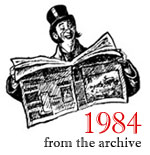
Journalism, Theology, & History
EDITORIAL
Secular newspapers are publishing articles on difficult Roman Catholic theological issues with increasing frequency.
It is fair to say, however, that nearly all secular analyses of the U.S. bishops’ recent pastoral letter on war and peace have ignored the fulcrum place of abortion and other life issues in that document’s systematic balance. Moreover, the stunning letter sent by Mother Teresa of Calcutta to the bishops on the errors of some religious sisters in the United States has become a dead letter as editors trip over each other to quote voices more sympathetic to those errors.
Pope John Paul II’s personalist phenomenology, and indeed all Catholic anthropology, gets reduced in The New York Times to a “papal war” against women. Hans Küng is declared by the same newspaper to be “a Roman Catholic theologian,” the Pontiff’s view notwithstanding.
Lord Melbourne is said to have remarked that things have come to a sorry pass when religion is allowed to interfere with one’s private life. But so long as it does intrude upon reality, those who report the spectacle are obliged at least to acknowledge the existence of certain principles that guide Catholic theology. This is particularly so when journalists report what they call division between the Pope and Catholics in the United States, and do it with an interest and consistency that suggest to the anxious reader that they almost wish it were so.
You May Also Enjoy
For anyone who still harbors doubts about the authenticity of the third Fatima secret as revealed by the Vatican, Tarcisio Cardinal Bertone's book is a must read.
For many, Catholicism as a religion has become irrelevant as they have capitulated to secular American culture, as did WASPs in the mainline Protestant denominations.
Not celebrating this feast has the effect of diminishing Easter by restricting the reception of the very gifts Christ offers us.

